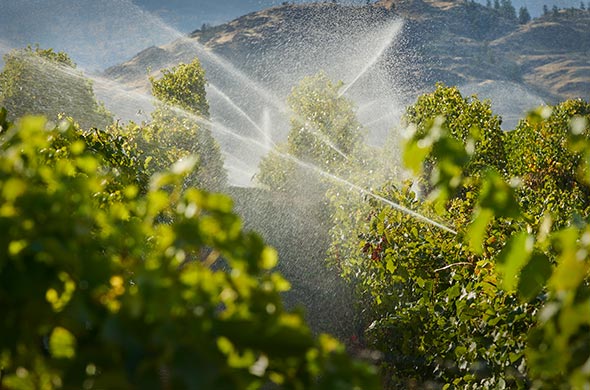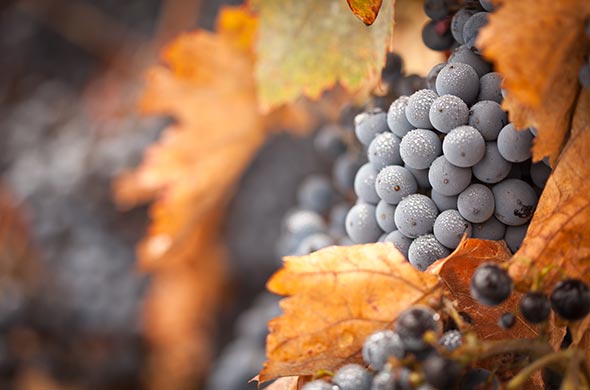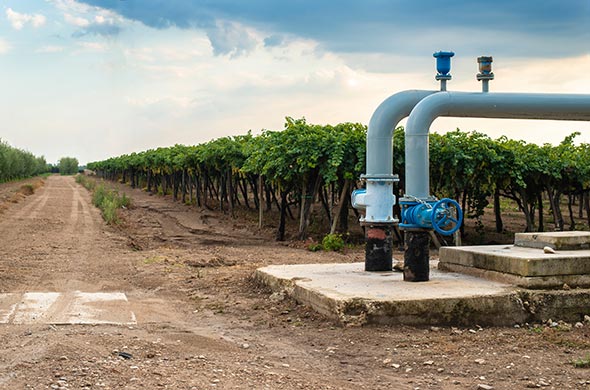
Water Quality
Introduction
- Wineries work primarily with fruit which are organic materials which can have high levels of nutrients within them. While this is essential for producing wine, the waste generated by using these can have an environmental impact. Anything that does not make its way into the final product must be discharged in some way as a waste product. In a winery, the primary ways waste is discharged is through wastewater from cleaning and sanitation processes, solid waste from crushing and pressing, and domestic waste associated with employees, tasting rooms, and events.
Background
- Wineries could be considered a point source pollution since the waste is generated from a single location. The environmental impact of a vineyard could be considered a nonpoint source pollution since waste may be produced from a large area distributed across the field. Distinguishing these sources is important as it affects how they are managed both in regulations and in practice. It is important to control pollution at its source to reduce its impact on local waterways. Point sources are much easier to control than nonpoint sources, so focus is typically placed on controlling point sources first.
- Basic water quality parameters include biological oxygen demand (BOD), total dissolved solids/suspended solids (TDS/TSS), salts (Na, K, etc.), nutrients such as nitrogen/phosphorus, and pH. BOD represents the organic matter in the water that leads to the consumption of oxygen in the water column. This can drive down the oxygen levels in the water making the waterbody unsustainable for fish and other wildlife. TSS/TDS represent particles in the water which can block sunlight and restrict the growth of vegetation and reduce visibility in the water column. Nitrogen and phosphorus are both limiting nutrients for aquatic vegetation. Excess nitrogen and phosphorus reaching waterbodies can lead to algal blooms and eutrophication which is detrimental to aquatic ecosystems. The water pH is also very important to overall water quality, so additions of high or low pH water can affect the overall chemistry of a waterbody negatively.
- While process wastewater from wineries from cleaning and sanitation can contain high levels of BOD and TDS as well as other pollutant loadings, the volume of process wastewater is often small from wineries. Most wastewater from wineries also has a fairly low pH of about 3 to 4 SU. Grape pomace left after pressing also is high in nutrients such as nitrogen, phosphorus, and potassium. The pomace can be composted using standard composting practices but needs to be combined with a bulking agent such as wood chips due to the high organic content. The finished compost can then be applied to agricultural fields.
Actions
Cleaning waste is by far the biggest contributor of wastewater at a winery because it is generated at every processng stage during wine manufacturing. While pollutant concentrations can be high in this wastewater stream, the pollutant loading is very low because the volume of wastewater is typically small. The winery is typically using less than 200 gallons of water when cleaning and sanitizing equipment, which happens 10 to 20 times per year. Lower pollutant loads result in a much smaller impact on the environment. The first option for managing wastewater at a winery is to direct the wastewater into a septic system. The septic system utilizes a septic tank to allow for the settling of solids, and the remaining water is then discharged into a septic field which allows the wastewater to disperse into the soil. This allows the removal of nutrients and other pollution from the wastewater. The second option is to use a storage tank to capture the wastewater and have it sent to a wastewater treatment plant. The third option is to apply the wastewater directly to the land, which may require testing to determine nutrient levels in the wastewater and how to ensure nutrients are properly distributed on the soil. Land application is the least expensive option and the most sustainable since it allows the nutrients in the wastewater to replenish nutrients in the soil, thereby improving the soil fertility.
Many other actions can be taken to try to further reduce the pollution load reaching the final treatment system or loads that are bypassing the system entirely. Aall areas with winery wastewater should have drains that direct the water into the wastewater management system. This should include the crusher and presser area. The winery wastewater and domestic wastewater streams should ideally be kept separate to allow systems to be optimized for their individual treatment. Stormwater runoff should also be kept separate from winery wastewater as the stormwater will dilute the pollution which can make it more difficult to remove or otherwise overwhelm the wastewater treatment system. Simple filters or grates can be used to remove large solids from reaching wastewater management systems.
Chemicals used for cleaning is another key area that should be considered when evaluating the impact wineries have on water quality since these chemicals end up in the rinse water. A regular inventory of chemicals should be completed to determine if more environmentally friendly alternative cleaners are available. The most common cleansers include caustic and acidic solutions. These products can affect the pH of the rinse water, but when used in conjunction should help neutralize the changes in pH. Since the rinse water is typically acidic in general due to the acidity of the grapes, prioritizing the use of caustic cleaners will help neutralize the pH. Many of the commonly used cleaners are sodium based. Use of sodium-based cleaners can have an impact on soil quality versus using potassium-based ones. Potassium ions help avoid the soil degradation that sodium ions will, and potassium is also a plant macro-nutrient. Potassium based products may be more expensive but may be offset by mediation costs associated with addressing soil impacts in wastewater utilization areas.
Chemical use for sanitation could be reduced by using ozone instead of an alternative chemical method. Ozone provides high sanitization as well as potential time and energy savings.
Summary/Conclusion
The wine making process can have impacts on water quality due to the high organic and nutrient content of the grapes. If wastewater is unmanaged, it can have negative impacts to nearby aquatic ecosystems. By practicing best management practices and ensuring the wastewater is being treated, these negative impacts can be avoided. Wineries should access their own wastewater management systems and determine what can be changed to better manage their waste streams.
Water Conservation
Introduction
- Many wineries depend on well water to operate their wineries as the chlorination in municipal supplies is not well suited for wine making. Water conservation is extremely important to avoid depleting the aquifer that the winery depends on. Overuse of well water in coastal regions can also lead to saltwater intrusion over time. Even when running on municipal water, water conservation is important to help preserve resources and can provide cost savings as well.
Framing
- When thinking about water use at a winery, it is important to focus on the cleaning and sanitation process as they account for approximately two-thirds of the water useage at a winery. While water conservation is important, thought must also be given to the fact that water use will result in concentrating the wash water further which could have impacts on the wastewater treatment systems. Both water conservation and water quality should be considered in tandem to balance any potential trade-offs.
Actions
- To begin trying to address water conservation, it is important to be able to track how much water is being used. The easiest solution is to install a water flow meter to track the water usage. It is important to place the water flow meter at the entrance of the production side of the facility to help separate water use from the tasting room activities to best access production side activities. The water usage can be recorded monthly to get a baseline for how much water the winery uses. Wineries on municipal water can use their monthly bills to help determine historical water usage.
- Once a baseline of water usage is established, changes can be implemented to see what impact they have on water usage. These activities should be incorporated into standard operating procedures, and staff should be trained to follow these procedures. Logistics should always be thought about critically when moving juice/wine around to minimize transfers since this will improve the efficiency of the operation while also reducing the need to clean tanks. These activities can include using brushes, brooms, and/or squeegees to pre-clean surfaces prior to using water. The relatively clean wash water or cleaning solutions should be reused wherever possible (e.g., using final rinses of tanks to prerinse other objects). Water recycling bins can be utilized while cleaning small picking bins rather than using hoses to rinse them individually. Low flow nozzles can also be added to the end of hoses to reduce the volume of water needed to wash tanks without sacrificing time or incurring large costs. Also the crush pad area can be shaded to help prevent grape residue from getting stuck on equipment, thereby reducing the amount of water needed for cleaning.
Conclusion
- Water conservation is needed at wineries to reduce the consumption of water from aquifers and can help reduce costs associated with water use. Wineries can track water usage and then implement a variety of simple practices to help reduce water consumption without sacrificing time or incurring large costs.
Recommended Literature for Winery Water Efficiency
Draft BMP Manual for Winerty Wastewater
Winery Process Wastewater Management Handbook: Best Practices and Technologies, 2018


